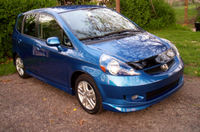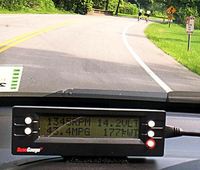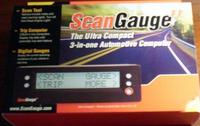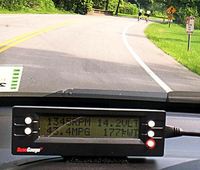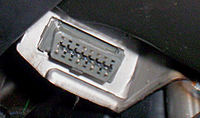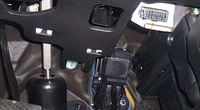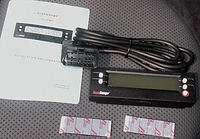A More Perfect Honda Fit: ScanGauge Let's You See How Efficiently You're Driving, Instantly
- SEE ALSO: A More Perfect (Honda)Fit- Accessories that don't cost an arm and a leg
- SEE ALSO: A More Perfect (Honda)Fit- Working Out the Bugs
- SEE ALSO: A More Perfect (Honda)Fit- More Perfect MPG Part One
- SEE ALSO: A More Perfect (Honda)Fit- More Perfect MPG Part Two
- SEE ALSO: ScanGauge Let’s You See How Efficiently You're Driving, Instantly
- SEE ALSO: Honda Specs, Pics and Prices-Honda Buyers Guide
 |
Louisville Bureau
The Auto Channel
In my last three columns I talked a bunch about how to improve mileage. The downside to all that knowledge is that you have to wait until fill up time to do the math and see how well you did. I don’t have that kind of patience.
That’s why one day my wife got in the car to drive her grandpa to the eye doctor and noticed a small, rectangular box Velcroed to the top of the dashboard. A black cable, like the kind you use to plug your computer into a network, dangled down past the steering wheel and disappeared underneath the dash. When she turned on the car, the box lit up and began displaying numbers.
“What’s that thing on the car?” she asked later.
I explained that the thing was called the ScanGauge II, my latest gadget for making a nearly perfect car even more perfect.
“Uh huh. Am I gonna have to learn how to use it?”
With just a little resistance, my wife eventually learned the right
button presses for calibrating the ScanGauge after a new tank of gas,
proving that the gadget is relatively user- and spouse-friendly.
I discovered the ScanGauge II while browsing the forum on fitfreak.net, where it was getting good reviews. Not only could it read the Fit’s engine computer data, but it had a built in trip computer that recorded stats for the current drive, day, previous day, and tank.
Retailing for about $160.00, the ScanGauge II, from Linear Logic of Mesa, Ariz., is cheaper than many products that read a car’s data, and has some great features packed into its pint size. My favorites? The ScanGauge:
- is conveniently small (about 5” x 1.5” x 1” deep)
- plugs into your Fit’s data port (didn’t know your Fit had a data port? Read on)
- doesn’t require a laptop or special software
- doesn’t need batteries (the power comes from the data port)
- has an adjustable backlight for night viewing
- uses flash memory, so your settings don’t disappear when it’s unplugged
- comes with two ports, one on the back and one on the side, so that you can plug in the cable where it’s most convenient.
- is portable: just plug in to a new vehicle and ScanGauge will read the data (you’ll have to change some settings to use the trip computer)
- displays four items at a time, with many more a button press away
Why it’s worth the money.
A Honda Fit, like almost all contemporary vehicles, is as much a computer as it is a car. You and the computer are really driving as a team, and the ScanGauge is one way to communicate with your co-pilot. Some quality communication lets me know if I’m really toning down the lead foot.
For instance, with the gauges displayed below I can try to maintain a constant speed (MPH, lower left), keeping to a constant throttle position when I’m driving on the flat or increasing slowly on a rise or to accelerate (TPS, upper left). I get instant gratification with my current miles per gallon (MPG, lower right), and pleasure at watching the average miles per gallon build up during the trip (FLc, for fuel average, upper right). Don’t stress over the abbreviations—the instruction book has a chart for decoding all the alphabet soup. Just remember to watch the road, and not the ScanGauge.
Changing the displayed gauges is easy; just push any of the four white buttons to cycle through the options. After a drive, I press the Home button (lower right, circled in red), which takes me to the main menu, then Trip.
In the Trip menu I can view stats for the current drive, current day, previous day and tank. Values are maximum speed, coolant temperature and RPM; average speed and fuel economy, trip miles, elapsed time, and fuel used. The next photo shows my fuel average for the previous day’s driving.
Using the Scan feature, I can get the same code my repair shop charges me $40 to figure out whenever an engine trouble light pops on (find a list of diagnostic codes at fitfreak.net. I can even clear the code myself.
By the way, you can also set up your own gauges, but that’s for more advanced users. If you decide to get one, here’s how to set it up:
Step 1: Find OBD-II. Hint: it’s not a character on Star Wars
Step 2: Plug it in
With the ScanGuage comes a cable, adhesive mounting strips and instruction booklet. Save the mounting strips for later--until you decide where to place it.
Plug the small end of the cable into one of the two ScanGuage ports (doesn’t matter which one), turn on the car, then plug the large end of the cable into the data port. The screen will read “Connecting…” for a moment. Once it does, enter the following information in the HOME> MORE> SETUP screen: fuel: gas, gas tank capacity: 10.5 gallons (you’ll have to enter 10 or 11 gallons—so don’t use the ScanGauge to tell you how much gas you have left), engine displacement : 1.5 liters. Note: These are the settings for my model, make sure to check your owner’s manual.
Step 3: Some training required
These settings will get most of the features to work, but for miles-per-gallon calculations to be accurate, the gauge needs some training. So don’t get excited if at first you see miraculous fuel economy. I had to adjust the Speed setting (MORE>SETUP>SPEED) to compensate for a difference between the Fit’s odometer and the ScanGuage’s distance calculation. And for the first few fill ups, I had to fine tune how much gas the ScanGauge reported I had used (MORE>FILLUP). Once it’s trained, your readings will be consistently accurate.
Wish List
Though I give the ScanGauge high marks, nothing’s perfect. Here are some things I wish Linear Logic would change in the next model:
- The screen quality can be improved – it becomes sluggish in cold weather and turns dark when it’s too hot.
- Summer heat softens the glue in the mounting strips--use industrial quality.
- Allow the gas tank capacity to be set in half-gallons.
- But even with these drawbacks, the ScanGauge II offers a lot in a little package. It’s one way to make a nearly perfect car, the Honda Fit, even more perfect.
Michael’s Honda Fit (2007 Sport AT) accessories and mods to date: Zeta Products dead pedal, armrest, satin dash kit, and hood deflector; Honda all-season floor mats, cargo tray, rear bumper appliqué, tonneau cover; ScanGauge II by Linear Logic, Airtabs by Aeroserve Technologies Ltd.
Michael Jackman is a Louisville, Ky. based writer and professor of writing at Indiana University Southeast. More info at www.mjfreelancer.com



